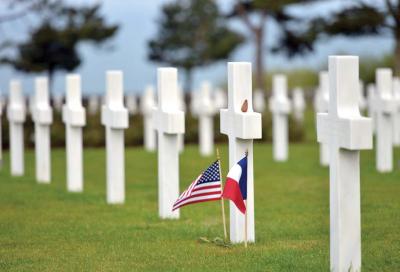June 3, 2015
 An American flag and a French flag offer tribute to a fallen US soldier at the American Cemetery at Colleville-sur-Mer, Normandy, where 9,387 American war dead are at rest. Stars and Stripes photo by Michael Abrams
An American flag and a French flag offer tribute to a fallen US soldier at the American Cemetery at Colleville-sur-Mer, Normandy, where 9,387 American war dead are at rest. Stars and Stripes photo by Michael Abrams
Re-published from 2015 OMAHA BEACH, Normandy – An awesome serenity abounds as visitors enter to the American Cemetery and Memorial in the French town of Colleville-sur-Mer. The burial ground sits high above the beach whose name speaks in the history books to high valor and the terrible cost of war. The spare white gravestones under which are buried the bodies of 9,387 US soldiers are set out precisely in row upon row into the far distance and they glisten under the noonday sun. This is a place made holy by the men who lie there close to where they fell in battle on that fateful day 71 years ago this week, June 6, 1944, and in the weeks that followed the western Allies’ invasion of Adolf Hitler’s Fortress Europe.
Some 200 feet below the graves, the Channel waters wash up onto the sands of Omaha Beach. To stand there so many years later and see for yourself what those thousands of young men faced on D-Day – a mass of beach front, a rocky shingle, a sturdy sea wall, and daunting grassy bluffs reaching to the sky where heavily armed German soldiers awaited – is to shudder in appreciation of what the human spirit can endure when the cause is clear and widely seen as just.
Other emotions surface randomly during a walk down the five-mile-long beach: sadness, for what these young men of my parents’ generation might have become; awe, for the heroic grit they showed in plunging ahead and up into a cauldron of violence and death; anger, at the clueless Germans for defending the indefensible actions of Hitler and his barbaric ensemble; gratitude, for how they showed us all that liberty comes at a dear cost that from time to time has to be paid in full.
There is a sense across Normandy that history has stopped in places to take a deep breath. Once-sturdy German coastal embattlements remain in place, if severely battered, and a visitor can step inside and check out the fighting quarters and look in astonishment at the huge craters that were made by the Navy’s guns on that bloody day. In other places, the Germans’ heavy guns – some of them had a twelve-mile range – sit akimbo in their slots 71 years after their last convulsions. And a drive through the Norman countryside reveals that the French have not forgotten D-Day: In virtually every village there is a roadside monument to the fighters who set them free.
Not to be outdone, the British placed their own memorial at the entrance to the Commonwealth Cemetery in Bayeux: “We, once conquered by William, have now set free the Conqueror’s native land.”
•••
The statistics provide the details of the D-Day story, the beginning of the end for the Germans who with their armies, the SS, and the Gestapo had terrorized Europe in murderous ways for some five long years:
• The Allies, beginning at the water’s edge, had to overcome the defenders’ strong positions above the five beaches of the invasion scenario: Utah, Omaha, Gold, Sword, and Juno. The enemy fortifications were part of the Atlantic Wall that was built mostly by the French to Hitler’s generals’ specification – 3,000 miles of minefields, concrete walls, concrete bunkers, barbed wire fences, fortified artillery emplacements, and all manner of obstruction in the Channel itself arrayed along the coastline from the top of Norway to the Spanish border in southern France.
• Some 160,000 Allied troops landed in Normandy on that first day (62,000 English, 73,000 Americans, and 21,000 Canadians). About 13,000 paratroopers of the US 82nd Airborne and 101st Airborne Divisions made night parachute drops in the wee hours of that morning and they were followed by 4,000 glider troops.
• Some 7,000 vessels crossed the Channel during the day, transporting troops and, along with the air forces, unleashing munition barrages of inhuman force onto the Germans’ coastal positions above the beaches.
For all that, things went terribly awry in places despite intensive planning. Not enough soldiers and officers ended up where they were supposed to. Most of the paratroopers landed in patches of countryside and wetlands in out-of-the-way places, and the precision of the movement of soldiers from the ships to the beaches and thence to the hills above was thwarted by the weather and by the strong defensive effort of the Germans.
The updated (via the US National D-Day Memorial Foundation) Allied death count for D-Day: 4,413 with some 2,500 of them Americans. German losses have been put at 4,000 to 9,000. For all that, after five days, there were 326,500 Allied troops moving into France and 105,000 tons of supplies on hand for them to fight with.
In the months ahead, millions of soldiers poured onto the continent from the west and the south. To the east, Russia’s mighty legions were pressing on in brutal fashion, laying waste to all in front of them. In eleven months, Hitler and his thousand-year Reich would be history.

